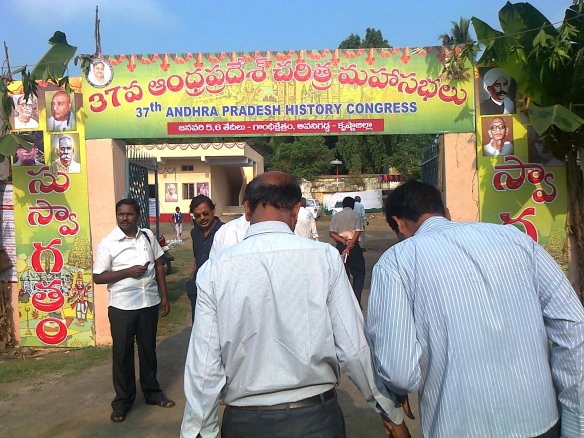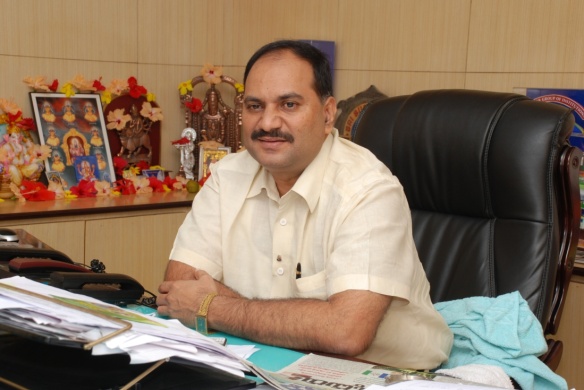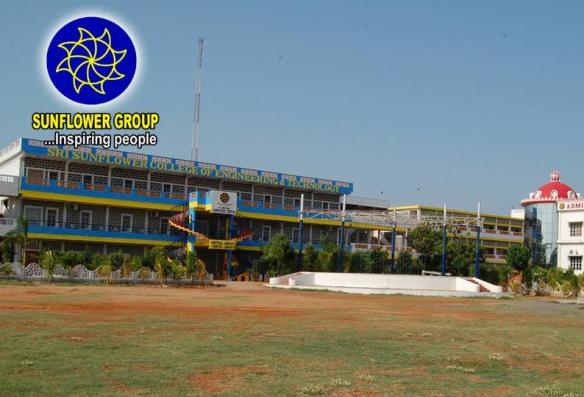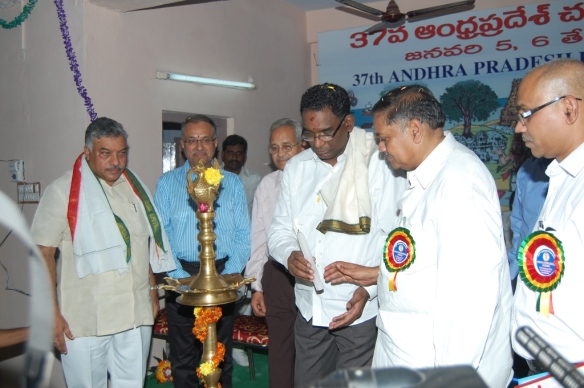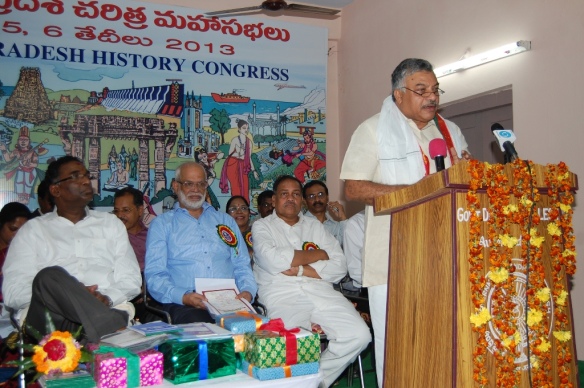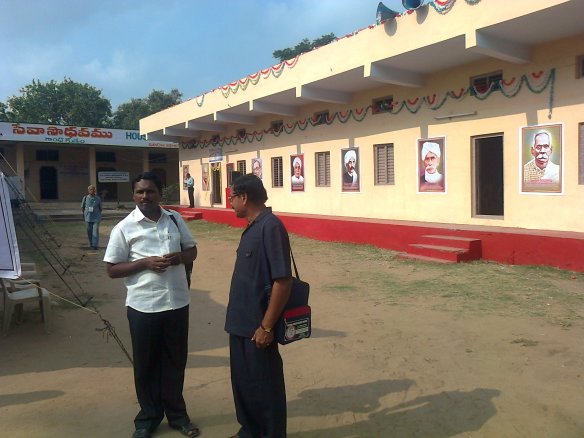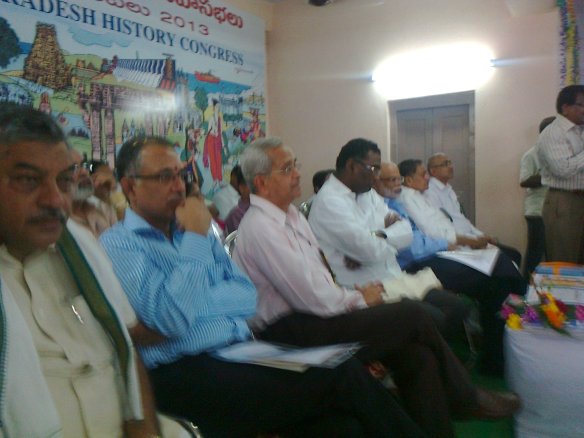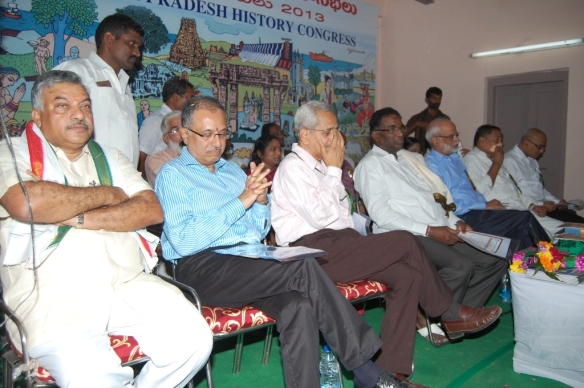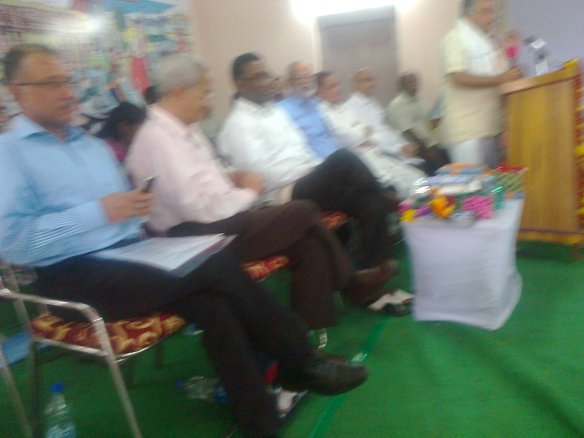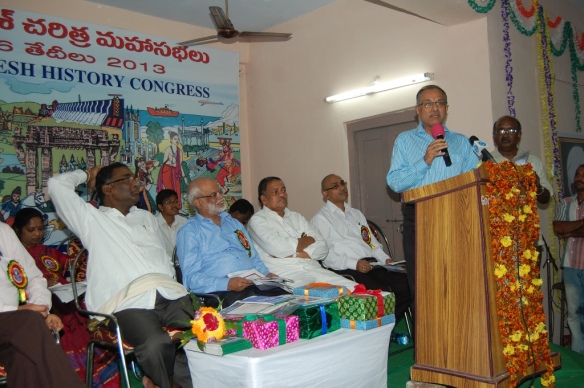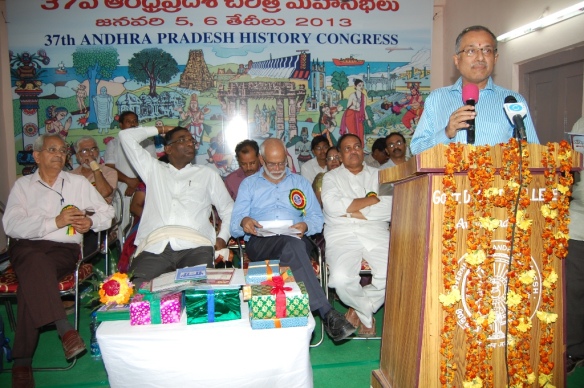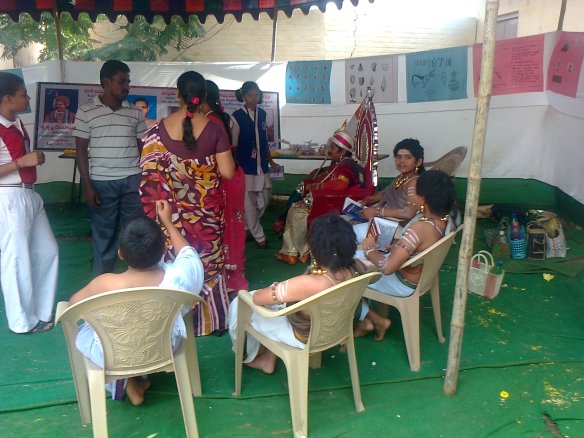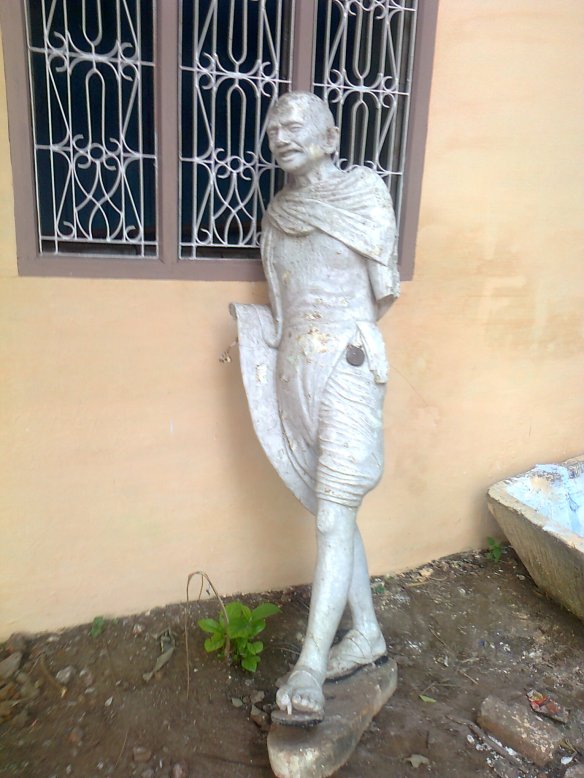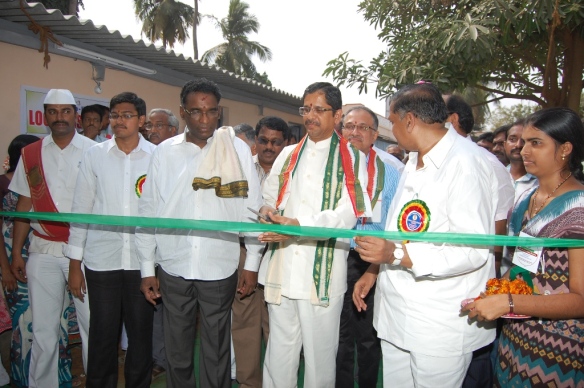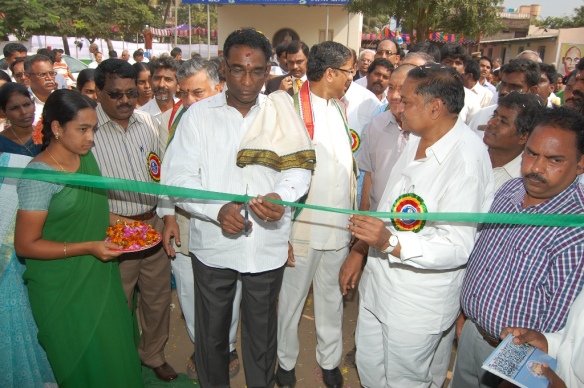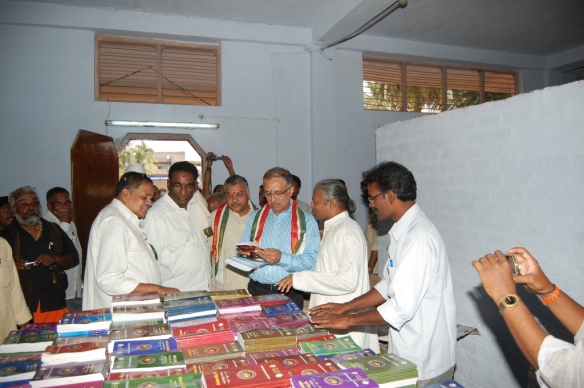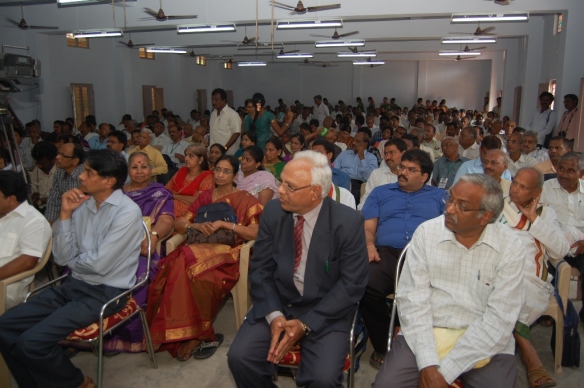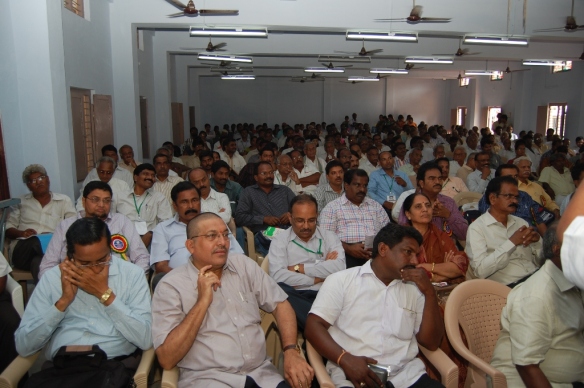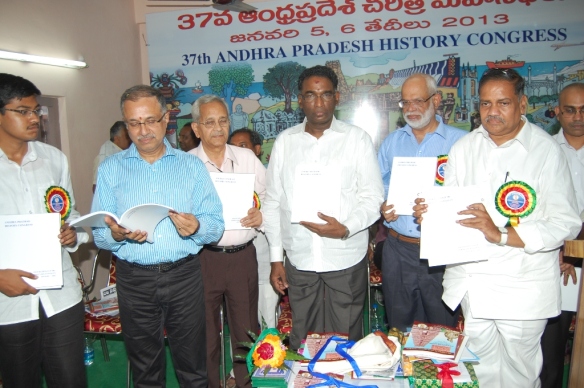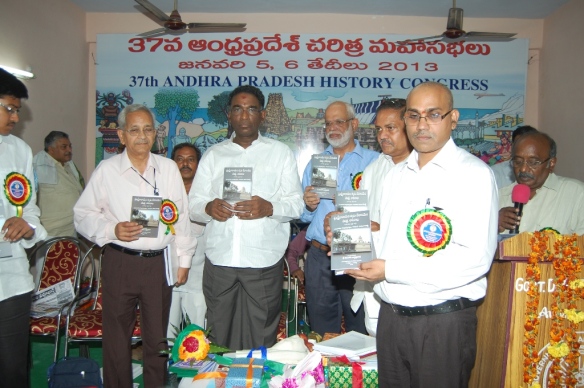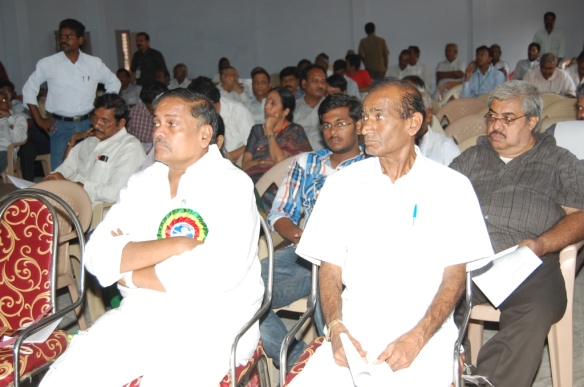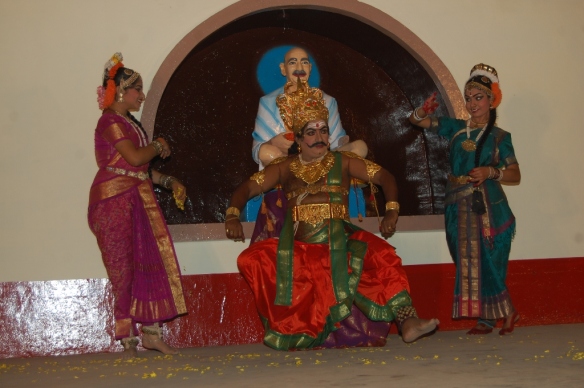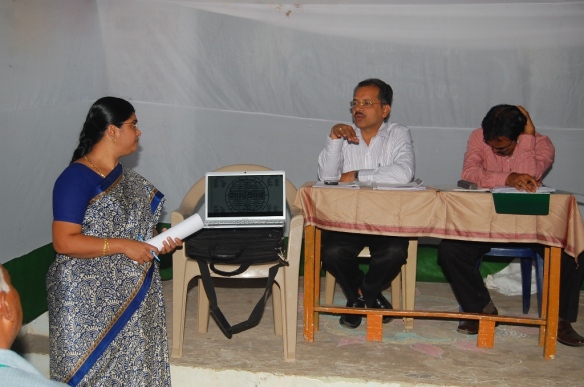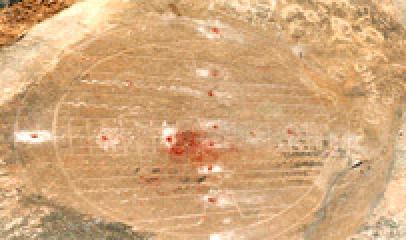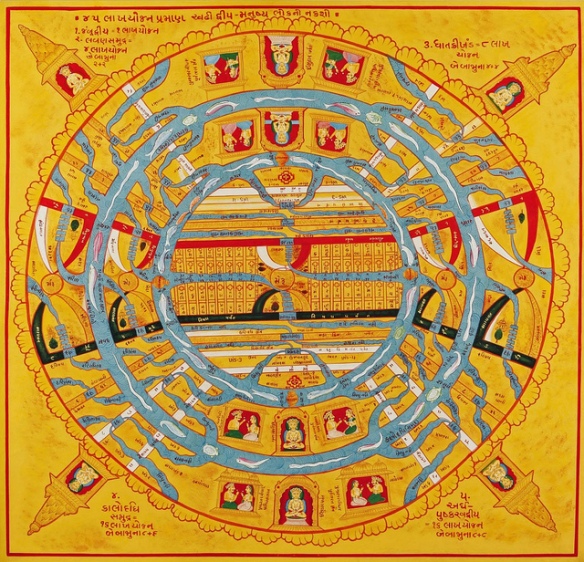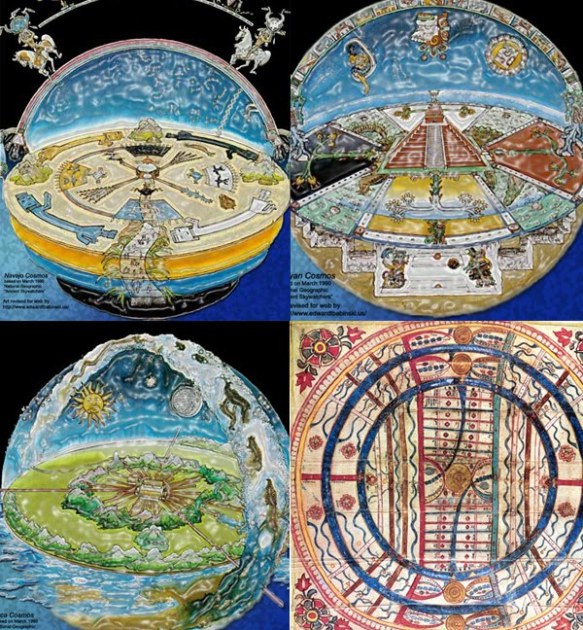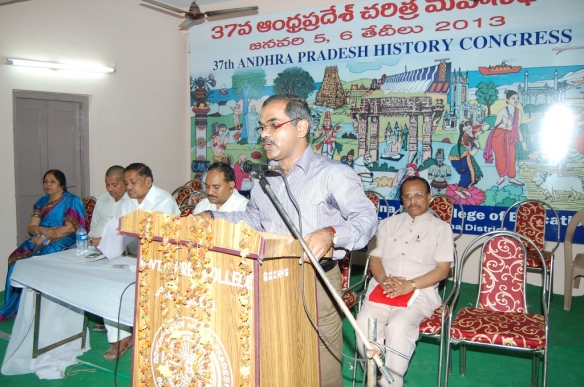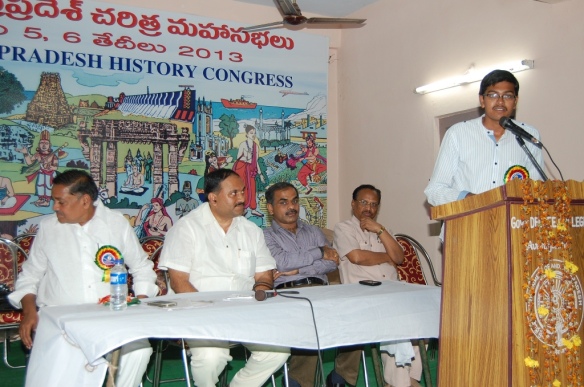The 37th session of Andhra Pradesh Annual History Conference, Avanigadda
The 37th session of Andhra Pradesh Annual History Conference was held at Avaigannda, Krishna district, Andhrapradesh. It was hosted by the Sri Mandali Venkata Krishna Rao College of education, Gandhi Khetram, Avanigadda, is the headquarters of Divi Taluk situated 38 kms east of Masulipatnam and 7 kms from Repalle. The delegates were received from the Vijayawada Railway station and Bus-stand and taken to Avanigadda by bus taking three hours journey.
As the place of session had been situated at a remote place, the strength of delegates had been less as compared to the earlier sessions. Yet, the organizers could manage to the three hundred delegates arrived from different parts of Andhra, Tamilnadu and Pondicherry. Mandali Venkatram, the Local secretary has been a young man, but could manage the entire show. Perhaps, for the first time, I could see a Youngman managing the proceedings of a history session.
The hospitality was shared by many personalities of which, Sri Punnam Raju[1], Secretary / Correspondent of Sri Sunflower College of Engineering & Technology[2] provided accommodation and Sri Mandali Buddha Prasad[3], local Congress leader and chairman of Telugu Sahitha Academy food and other facilities.
The delegates were accommodated at the hostels of engineering college and school run by Sri Sunflower Educational Society.
The inauguration was done at the auditorium of Gandhi Khetram, Avanigadda and the Supreme Court Judge Justice Jasti Chelameswar inaugurated the conference on 5th morning. Hyderabad Central University Vice-Chancellor Ramakrishna Ramaswamy, Bharata Sahitya Academy secretary K. Srinivasa Rao and other spoke. The recollection of the Judge about the preserving and disposal of “historical documents and monuments” had been interesting and thought provoking.
He also recalled the services of the great king Sri Krishnadevarayalu for Telugu literature[4]. But, it was a great concern that the history was neglected a lot, he said.
Mr. Buddhaprasad said that the land of Telugu and the language has a glorious past. Many historic temples are located in Diviseema, which was also the birthplace of Siddendrayogi, Pingali Venkaiah and other great poets…….The government should present awards to the great historians, who served the motherland, he said and asked the delegates to spread the message on the importance of Telugu culture, tradition and language to one and all. Researchers spoke on ancient history, medieval history, modern history and on local history. Prof Kesavan Veluthat[5], University of Delhi was the General President of the session replacing Prof R. Soma Reddy. Prof. Kesavan Veluthat’s address was “Regional history in the making of regions”.
After the ritual of inauguration, the technical session of paper reading started and the Sectional Presidents as usual started reading their papers from the printed booklets, which were customarily circulated to all delegates as follows:
| Sl.No | Period | Sectional president | Title of the paper presented |
| 1 | Ancient Andhra history and archaeology | Prof V. Menakumari | Architecture in Andhradesa: A brief study |
| 2 | Medieval | Prof Kiran Kranth Choudary | Tax terms – Vijayanagara period |
| 3 | Modern | Prof E. Sudharani | Exploring women’s history during Asaf Jahis: Initial reflections and prospects. |
| 4 | Historiography | Prof B. Surendra Rao | Why Historiography? |
| 5 | Local History | Dr G. V. Purnachandu | Prachina Krishna tiram (Ancent Krishna Region – a Relook) – maru chupu (in Telugu) |
They read their papers in theie respective sessions followed by the presentation of papers by the professors, lecturers, researchers and students of history.
| Sl.No | Period | Sectional president | No. Of papers presented |
| 1 | Ancient Andhra history and archaeology | Prof V. Menakumari | 13 |
| 2 | Medieval | Prof Kiran Kranth Choudary | 21 |
| 3 | Modern | Prof E. Sudharani | 42 |
| 4 | Historiography | Prof B. Surendra Rao | 2 |
| 5 | Local History | Dr G. V. Purnachandu | 25 |
557 entrance of the venue
Inside the venue – LHS – History exhibition (hidden); backside – book exhibition; RHS – the auditorium where inauguration and valedictory functions were held.
The following have been my observations. The judge was sitting, whereas, Soma Reddy next to him seen sit cross-legged.
The judge was looking at him, making observations, expressions on the face etc., but he could not understand or otherwise!
So he too had lift his leg and do like his RHS man doing!
Earlier, he was making several gestures to make him understand perhaps!
567, 243, 244 – The was looking at him for his mannerism as both the historians sitting on his left (Kesavan Veluthat) and right (Soma Reddy) were sitting cross-legged;
254 – after some time judge also sit cross-legged, and the left-side historian sit normally now!
568 – children sitting depicting different historical personalities of India.
569 – same as above another view
558 – the Gandhi statue both hands broken placed backside, RHS of the book exhibition
559 – same as above – another view – perhaps, he could have been accommodated elsewhere in the “Gandhi-khetram”!
Inauguration of photo-exhibition
115 – inauguration of History exhibition by the judge
137 – book exhibition – telugu books
150 – book exhibition – ICHR
186 – section of the audience during the inaugural function
187 – another view of the audience
191 – yet another view of the audience
270 – Souvenir released
280 – proceedings released, but, as usual it was not distributed to the delegates.
288 – book released
298 – yet another book released
328 – 5th evening, Mamidipudi Venkatarangaiya Memorial Lecture was delivered by Prof B Surendra Rao, Mangalore University on “Nationalism and Historical writing”. His anxiety about history loosing importance was revealed through his observations. He lamented[6] that, “In independent India historians are not allowed to explore or explain history, as, for example, scientist are privileged to do about their respective subjects…”, ignoring that history cannot be “objective”. His ambiguity was revealed subsequently[7]. Though, there have been different interpretations of history and historiography, developed and applied in India thrusted on Indians, only “communal” variety has to be taken for discussion. Why and how the so-called “Muslimness” remained long for it to become “a site of political and ideological warfare” has not been brought out, instead, he poses “V. D. Savarkar, M. S. Gowalkar and others (others are not named)[8] as the counterparts of “Muslimness” i.e, “Hindutva” without referring to the recent publications.
A careful reading of his whole paper criticises “nationalist” historiography and the writing of history “under national flag”, but he fails or reluctant to the duty of so-called historians to present the Indian history in right perspective. Why the so-called histories have not delivered the “right Indian history” without nationalism, right-wing narcissism, orientalism etc., to suit ordinary Indians or consumers of “history”, as he perceived. As many paper readers do not come to conclusion or have guts to pronounce categorically what is his result, he has also ended with warning to such “nationalist” historiographers of different categories. Therefore, he has added one more verbose paper to the existing category. To quote his last two lines, “Is history too important to be left out tio care of historians, or it is an assertion, sometimes bordering on clumsiness, of the consumer’s sovereignty that sets aside the historian’s labours and judgments? Either way the nationalist fervour or label does not seem to promise much freedom to the historian as it does to the assertive consumers of history”.
A section of the audience during the Memorial lecture.
372 – cultural program
402 – cultural program – audience view
181 – paper reading session
184 – Medieval history – here, one lady presented a paper on “Jambudwipa at Konakondala” claiming that for the first time she discovered it. In fact, There have been plenty of material already available about the so-called “Jambudweepa at Konakondala”:
Jambu Dweepa at Konakondla[9]: “The Jain Mythical cosmographical diagram of Jambu Dweepa engraved on a stone on the top of the hill Alchemists at Konakondla village in Vajrakarur Mandal which was identified by Sri R.V. Chakravarthy, Head Master, Parishad High School, Konakondla in the year 1966. The pilgrims, especially south Indian Jain pilgrims are mostly attracted by this Jambu Dweepa which is 70 kms from Anantapur or 10 kms from Guntakal Railway Station. Adjacent to this, there are Kambam Narasimha Swamy Hills, Rasasidda hillock and Kari Basappa hillock. There is a Thirthanka Temple with idols of Thirthankaras (high priests) on Rasasidda hillock. This may belong to 13th Century A.D”. [details as per the website].
The paintings, drawings and sketches of it are available in different books and nowadays can be downloaded from the website also. Yet, the paper presenter claimed that she only discovered it, in spite of the facts mentioned above. Moreover, she had chosen to another “black and white” sketch to explain the “puranic description” of Jambudwipa. As it was identified in 1966 and photos were also taken, it is evident that it was there already by that time. Moreover, the paper-presenter never showed tis picture, instead, she was showing one sketch from some other book. Therefore, when pointed out and asked about the dating, he could not explain.
For illustrative purposes, some of the pictures have been reproduced below:
A painting of modern period – is available for sale!
Comparing with the above, here, we can note more depictions have been there surrounding the “Jambudwipa”
A comprehensive depiction of two-dimensional picture into three-dimensional – similar to Sri-chakra Mahameru.
205 – valedictory session
216 – young Local secretary.
Acknowledgment: I thank Sri Mandali Venkatram, the young and energetic local secretary for providing above photos (of the session).
[1] The Secretary & Correspondent Sri Sunflower Educational Society has the experience of running two well reputed schools in two different Mandals in Krishna District of Andhra Pradesh for the last twenty years with a student’s strength of above 2000. the Secretary & Correspondent of this Institution, he was proud of moulding many of his school children as Engineers, doctors and Officers who proved themselves worthy and deserving both within India and abroad. Besides, the society started a Junior College, which has won many laurels from the public for its outstanding academic performances within short span of time (2 years from establishment). Further, the secretary has vast and rich experience in conducting several career guidance and personality development programs for students and youth, by being a Lions Club District Chairman for the same. The Secretary of the society successfully introduced many dynamic and revolutionary experiments in academic as well as administrative aspects. Above all, he is blessed by the grace of the almighty in maintaining a very social relationship with all the parents and students which in turn makes him to comprehend and psychiatric and psychological fluctuations of the tender minds and there by to assist them to cross over their hidden reasons that make them academically backward. http://www.sunflowercet.org/chairman.php
[3] Sri Mandali Buddha Prasad born to Sri Mandali Venkata Krishna Rao, Smt. Prabhavathi Devi on 26.05.1956 at Nagayalanka Village in Krishna District, Andhra Pradesh. His father Sri Mandali Venkata (M.V.) Krishna Rao was a staunch follower of Gandhian Philosophy and a social worker. He served as a Member of Parliament and a Cabinet Minister in the State for a long time and influenced the State politics. He got the rare distinction of conducting the First World Telugu Conference during the year 1975, thereby bringing all Telugu people scattered throughout the world to one platform. His services to the victims of cyclone and tidal wave that hit the coastal area of Andhra Pradesh on 19 November 1977 were attracted the entire world and still remembered. He is known as a great humanist and selfless leader.Sri Mandali Buddha Prasad attained all the great qualities of his father and is moving in his footsteps. After completing his primary and high school education at Avanigadda, Krishna District, Sri Buddha Prasad graduated from Osmania University, Hyderabad.
[4] Incidentally, “A Neglected Emperor Poet” by Gadicherla Hari Sarvottama Rao was circulated among the delegates .
[5] I used to meet him at the sessions of IHC and discuss about Sangam literature, as he used to present papers.
[6] Prof B Surendra Rao, Nationalism and Historical writing, fn.1, p.22
[7] See fn.2, p.22.
[8] P.16.

